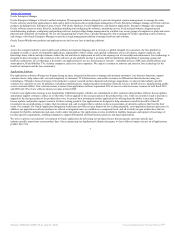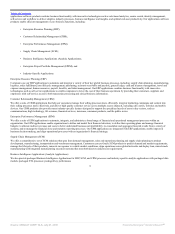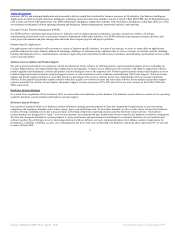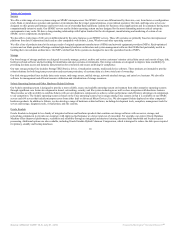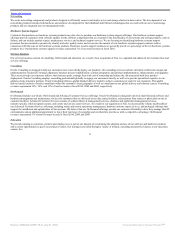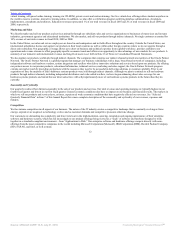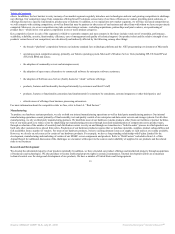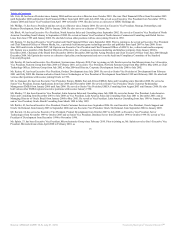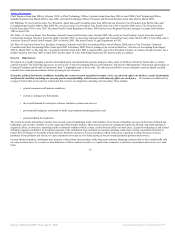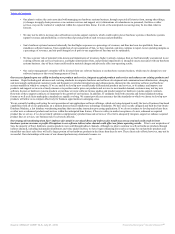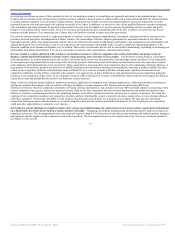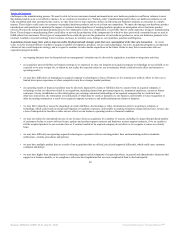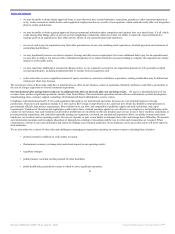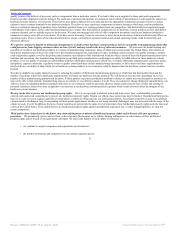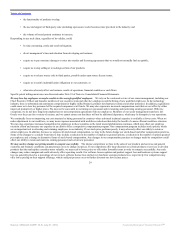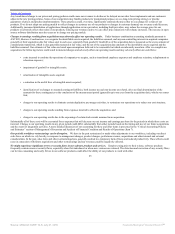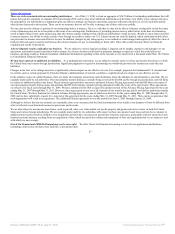Oracle 2009 Annual Report Download - page 21
Download and view the complete annual report
Please find page 21 of the 2009 Oracle annual report below. You can navigate through the pages in the report by either clicking on the pages listed below, or by using the keyword search tool below to find specific information within the annual report.
Table of Contents
In addition, terrorist attacks around the world, the wars in Afghanistan and Iraq and the potential for other hostilities in various parts of the world, potential public
health crises and natural disasters continue to contribute to a climate of economic and political uncertainty that could adversely affect our results of operations
and financial condition, including our revenue growth and profitability. These factors generally have the strongest effect on our sales of new software licenses,
hardware systems products, hardware systems support and related services and, to a lesser extent, also may affect our renewal rates for software license updates
and product support.
We may fail to achieve our financial forecasts due to inaccurate sales forecasts or other factors. Our revenues, and particularly our new software license
revenues and hardware systems products revenues, are difficult to forecast, and, as a result, our quarterly operating results can fluctuate substantially. Our limited
experience with managing our new hardware business and forecasting its future financial results creates additional challenges with our forecasting processes.
We use a “pipeline” system, a common industry practice, to forecast sales and trends in our business. Our sales personnel monitor the status of all proposals and
estimate when a customer will make a purchase decision and the dollar amount of the sale. These estimates are aggregated periodically to generate a sales
pipeline. Our pipeline estimates can prove to be unreliable both in a particular quarter and over a longer period of time, in part because the “conversion rate” or
“closure rate” of the pipeline into contracts can be very difficult to estimate. A contraction in the conversion rate, or in the pipeline itself, could cause us to plan
or budget incorrectly and adversely affect our business or results of operations. In particular, a slowdown in IT spending or economic conditions generally can
unexpectedly reduce the conversion rate in particular periods as purchasing decisions are delayed, reduced in amount or cancelled. The conversion rate can also
be affected by the tendency of some of our customers to wait until the end of a fiscal period in the hope of obtaining more favorable terms, which can also
impede our ability to negotiate and execute these contracts in a timely manner. In addition, for newly acquired companies, we have limited ability to predict how
their pipelines will convert into sales or revenues for at least one or two quarters following the acquisition, and potentially longer with respect to our acquisition
of Sun. Conversion rates post-acquisition may be quite different from the acquired companies’ historical conversion rates. Differences in conversion rates can
also be affected by changes in our business practices that we implement with our newly acquired companies that may affect customer behavior.
A substantial portion of our new software license revenue contracts and hardware systems products contracts is completed in the latter part of a quarter and a
significant percentage of these are large orders. Because a significant portion of our cost structure is largely fixed in the short term, revenue shortfalls tend to
have a disproportionately negative impact on our profitability. The number of large new software license transactions, and to a lesser extent hardware systems
products transactions, also increases the risk of fluctuations in our quarterly results because a delay in even a small number of these transactions could cause our
quarterly revenues and profitability to fall significantly short of our predictions.
We may not achieve our financial forecasts with respect to our acquisition of Sun or our entrance into a new hardware systems business, or the achievement
of such forecasts may take longer than expected. Our profitability could decline if we do not manage the risks associated with our acquisition and integration
of Sun. The acquisition and ongoing integration of Sun into Oracle may adversely affect our profitability if we do not manage the associated risks. We may not
achieve the anticipated synergies, cost savings, customer and partner advantages and benefits or realize our estimated revenue, profit or other financial
projections in a timely manner or at all due to a number of factors, including:
• Prior to the acquisition of Sun, we had limited or no direct experience in managing certain aspects of a hardware systems business. While we plan to
retain a large number of Sun engineers, salespeople and other employees with experience in managing this business, our inexperience or the
unplanned departures of some important employees could adversely impact our ability to successfully manage our hardware systems business,
which could adversely impact our ability to realize the forecasts for our hardware systems business and its results of operations.
17
Source: ORACLE CORP, 10-K, July 01, 2010 Powered by Morningstar® Document Research℠


